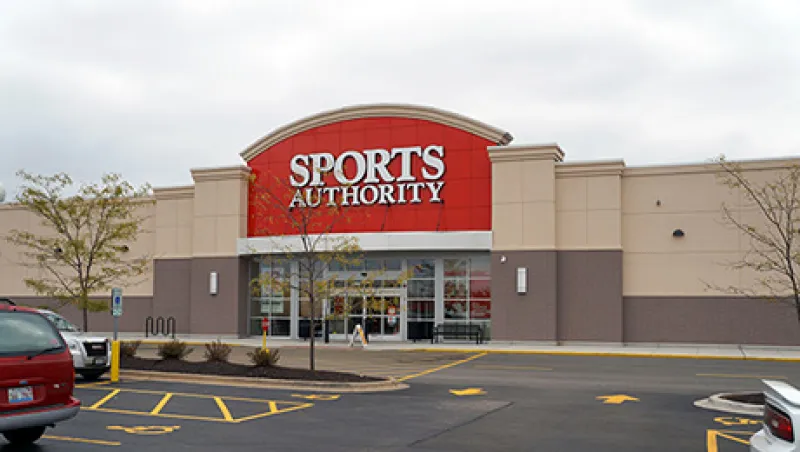U.S. brick-and-mortar retailers have been shuttering hundreds of stores, a trend highlighted by last month’s announcement that Englewood, Colorado–based Sports Authority will close all of its 460 locations. Despite the carnage, investors who own retail space are faring better than would appear at first glance.
The vacancy rate for U.S. retail property dipped to 7.9 percent in the first quarter of 2016, down from 8.3 percent for the same period in 2015, according Cushman & Wakefield, a commercial real estate services firm headquartered in New York. Year-over-year the average rent rose during the first quarter to $26.08 per square foot, from $24.48.
Meanwhile, shares of retail real estate investment trusts generated a 5.37 percent return through the first four months of 2016, after gaining 4.56 percent last year, according to the Washington-based National Association of Real Estate Investment Trusts.
Why the disconnect? Although old-fashioned stores face stiff competition from e-commerce, the demise of some merchants is being offset by the expansion of others — primarily discount department stores, dollar stores and specialty grocers.
Those conflicting trends give David Bujnicki, senior vice president of investor relations and strategy at Kimco Realty Corp., a REIT based in New Hyde Park, New York, reason to dismiss the scary headlines.
“It’s really more of a media-driven event about the death of retail than anything else,” says Bujnicki, whose firm has an $11.9 billion market capitalization. “There’s still a large demand for retail space, and you’re seeing a lot of retailers looking to open stores.”
Bujnicki admits that there are challenges: Kimco owns 25 Sports Authority locations, and the landlord keeps tabs on struggling merchants. “We really have to monitor the health of those tenants on our watch list,” he says.
Jay Carlington, an analyst at commercial property research firm Green Street Advisors in Newport Beach, California, agrees that the gloom surrounding store closings doesn’t capture the full reality of the retail market. “The retail sales environment remains fairly healthy and reflects the backdrop of good consumer spending and a stable job market,” Carlington says.
Overall, the retail market is robust, contends Michael Moriarty, a Chicago-based partner with consulting firm A.T. Kearney’s consumer products and retail practice. “Occupancy rates look good,” Moriarty says. “Square footage sales look good.” But the pressure on lower-performing retailers and their landlords will continue, he adds: “I’ve heard estimates that there is 30 to 35 percent too much retail space. That’s only going to get worse.”
Low-performing shopping centers have been hit especially hard, observes John Talbott, associate director of the Center for Education and Research in Retailing at Indiana University’s Kelley School of Business. REITs such as General Growth Properties and Simon Property Group have pared poor performers from their portfolios. “They’ve done a good job of offloading the third-tier malls,” Talbott says. “The good malls are still full.”
These certainly aren’t boom times. Recognizing that retailers are under stress, investors have slowed development of properties. Some 21.5 million square feet of new U.S. retail space was under construction in the first quarter, down from 25.8 million during the first three months of 2015, according to Cushman & Wakefield.
This retreat owes much to the fact that so many prominent retailers are struggling, even as the economy keeps growing. Tight supply creates a “tailwind” for Kimco’s 96 million-square-foot portfolio, Bujnicki says. “You’re going to see very limited ground-up development.”
Ronald Friedman, a partner and head of the retail and consumer products practice at New York–based accounting and advisory firm Marcum, doubts that the climate for landlords is as rosy as it seems. In response to growing competition from online retailers, many tenants have negotiated rent concessions that keep them in their space while paying less, Los Angeles–based Friedman says: “Amazon is just beating the pants off everybody.”
Macy’s, which has dual headquarters in Cincinnati and New York, announced in January that it would close 36 stores. In April regional chain Sport Chalet of La Cañada Flintridge, California, said it would shutter all 47 of its locations. Office Depot is concluding a program to close 400 stores in the wake of the Boca Raton, Florida–based company’s 2013 merger with rival OfficeMax. Larger competitor Staples, based in Framingham, Massachusetts, closed 73 stores last year and plans to mothball another 50 in 2016.
For every retailer that’s pulling back, however, another is spreading its wings. For instance, T.J. Maxx and Marshalls, both owned by Massachusetts–based TJX Cos., added 69 U.S. locations between them in 2015. TJX plans to open 60 more stores this year, according to its annual report. Fellow discounters Ross Stores, Dollar Tree and Dollar General Corp. all expanded in 2015, with the last growing by 694 locations, the Goodlettsville, Tennessee–based company’s annual report notes.
Grocers are expanding too. Last year Austin, Texas–based Whole Foods Market added 32 supermarkets, according to its annual report, and announced plans for a 1,200-location network of smaller stores, called 365 by Whole Foods Market.
Factory outlets are also on the rise, says Steven Tanger, president and CEO of Tanger Factory Outlets Center, a Greensboro, North Carolina–based operator of 42 outlet malls. “The broad-brush headline is that they’re closing stores,” Tanger says. “But the outlets are still a high-return, low-cost distribution channel.”
Many brick-and-mortar merchandisers find they’re competing not just with Seattle-based Amazon.com but also with their own e-commerce operations. “E-commerce share gains will continue to put pressure on the traditional brick-and-mortar retail industry for the foreseeable future,” Green Street’s Carlington says. “That said, this is not a new challenge.”
Tanger waves off e-commerce as similar to the rise of catalogue retailers. “People said, ‘Why in the world would you get in your car and go to the shopping venue when you could just walk to the mailbox?’” he recalls.
Brick-and-mortar merchants ended up outlasting the catalogue companies. Still, Amazon poses a more existential threat to physical retailers than catalogues did. Over the past decade the rise of the Internet giant and the popularity of digital media hastened the demise of movie rental chain Blockbuster, bookseller Borders Group, music chains Tower Records and Virgin Megastore and electronics seller Circuit City Stores. Office Depot and Staples say Amazon has hurt their sales too.
But Amazon hasn’t killed every category just yet. Groceries remain a viable brick-and-mortar business, as shown by the expansions of the Fresh Market, Trader Joe’s and Publix Super Markets. For now, at least, food sales have proved Amazon-proof. “The ability of e-commerce to make the last mile of delivery profitable remains a significant challenge for the Amazons of the world,” Carlington says, referring to the difficulty of getting groceries to consumers’ homes.
Get more on corporations.






